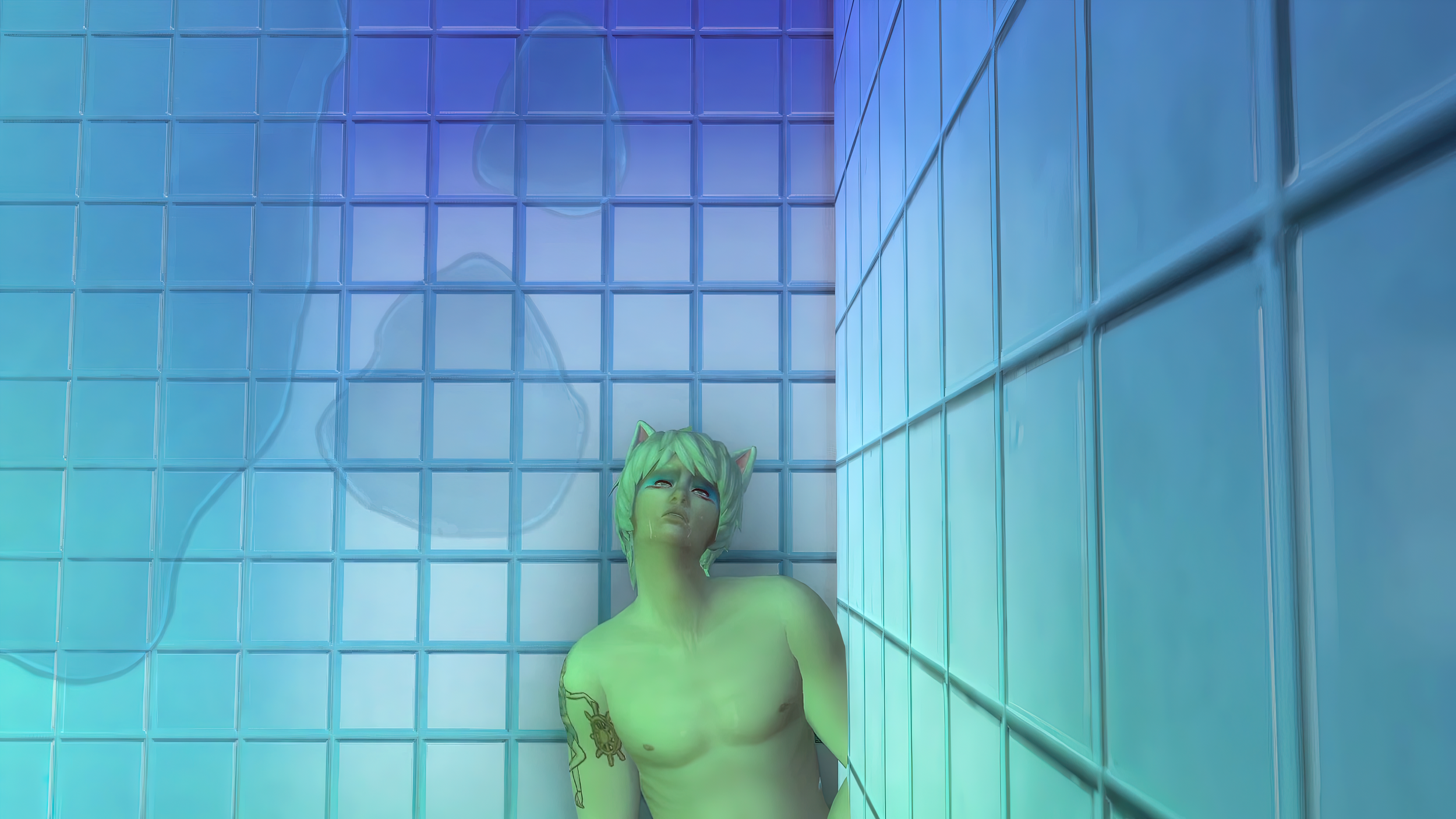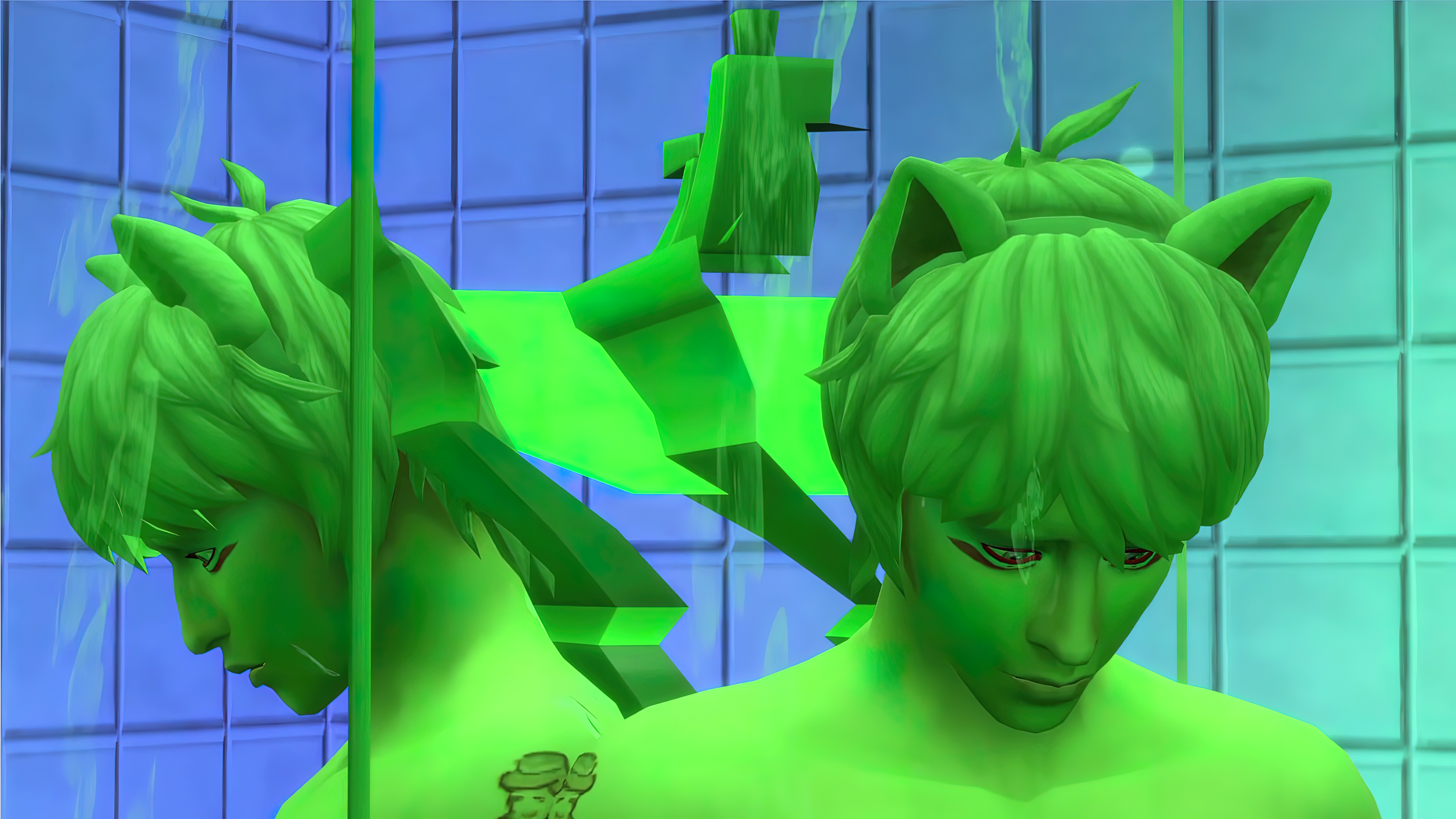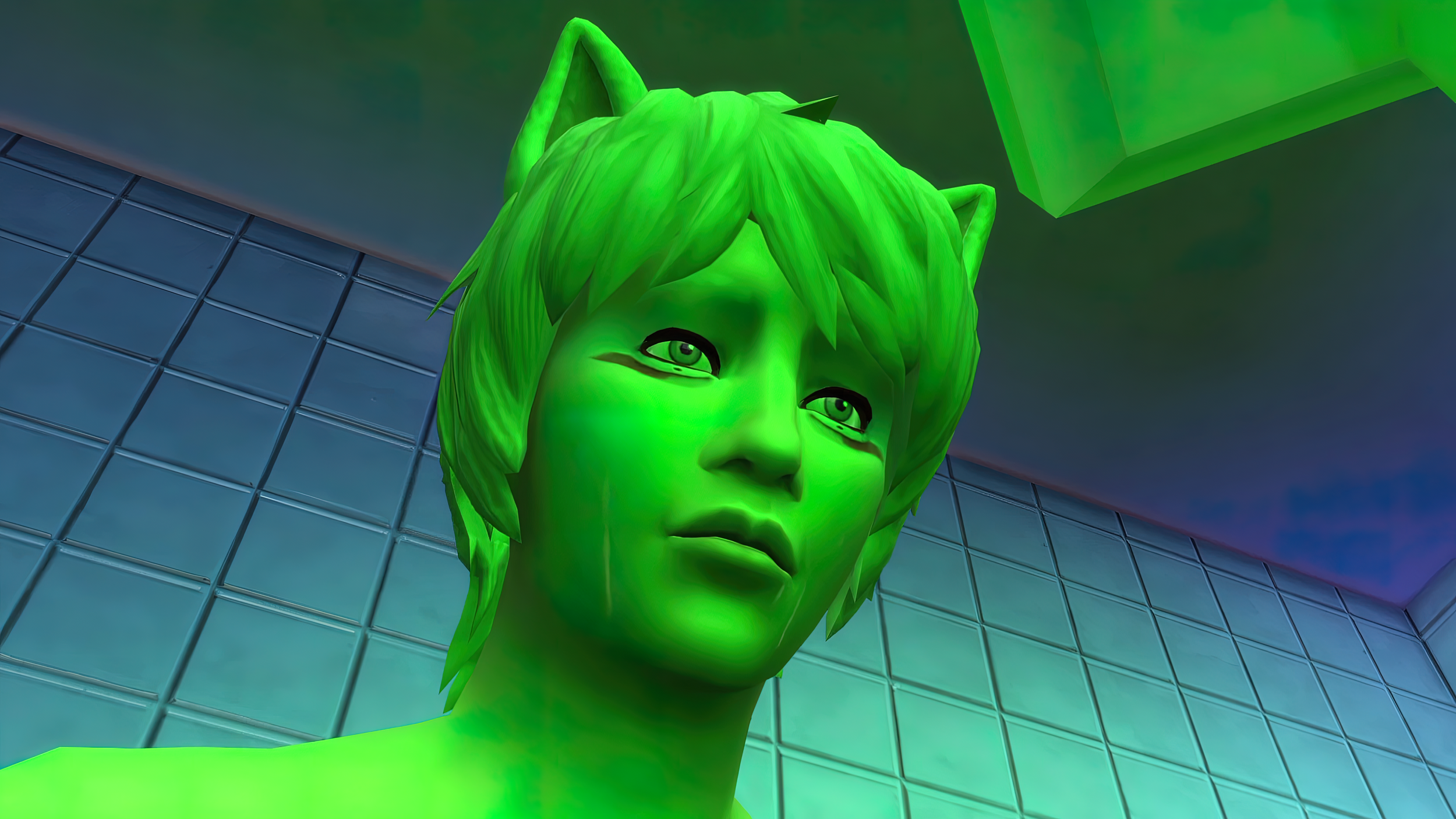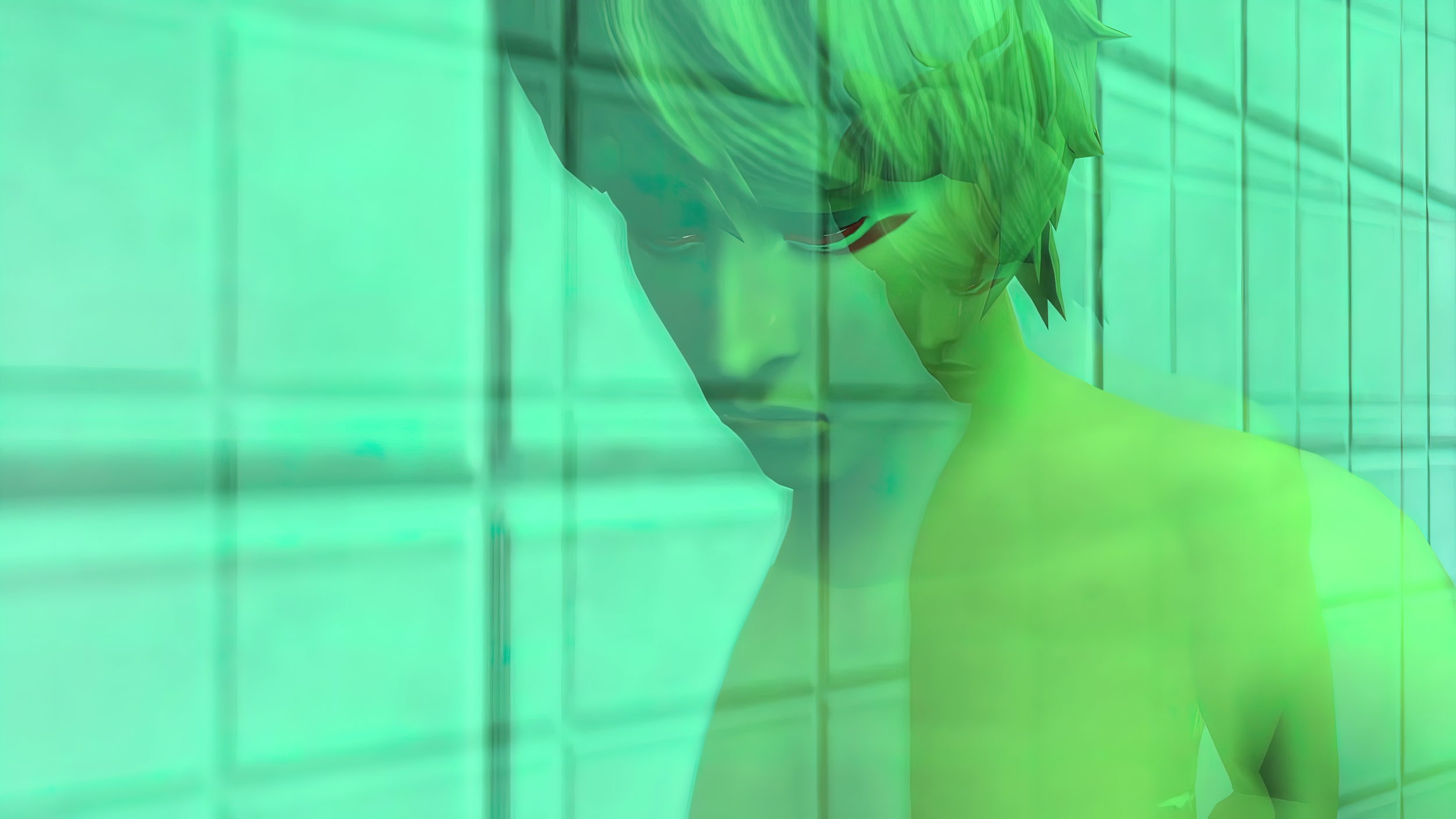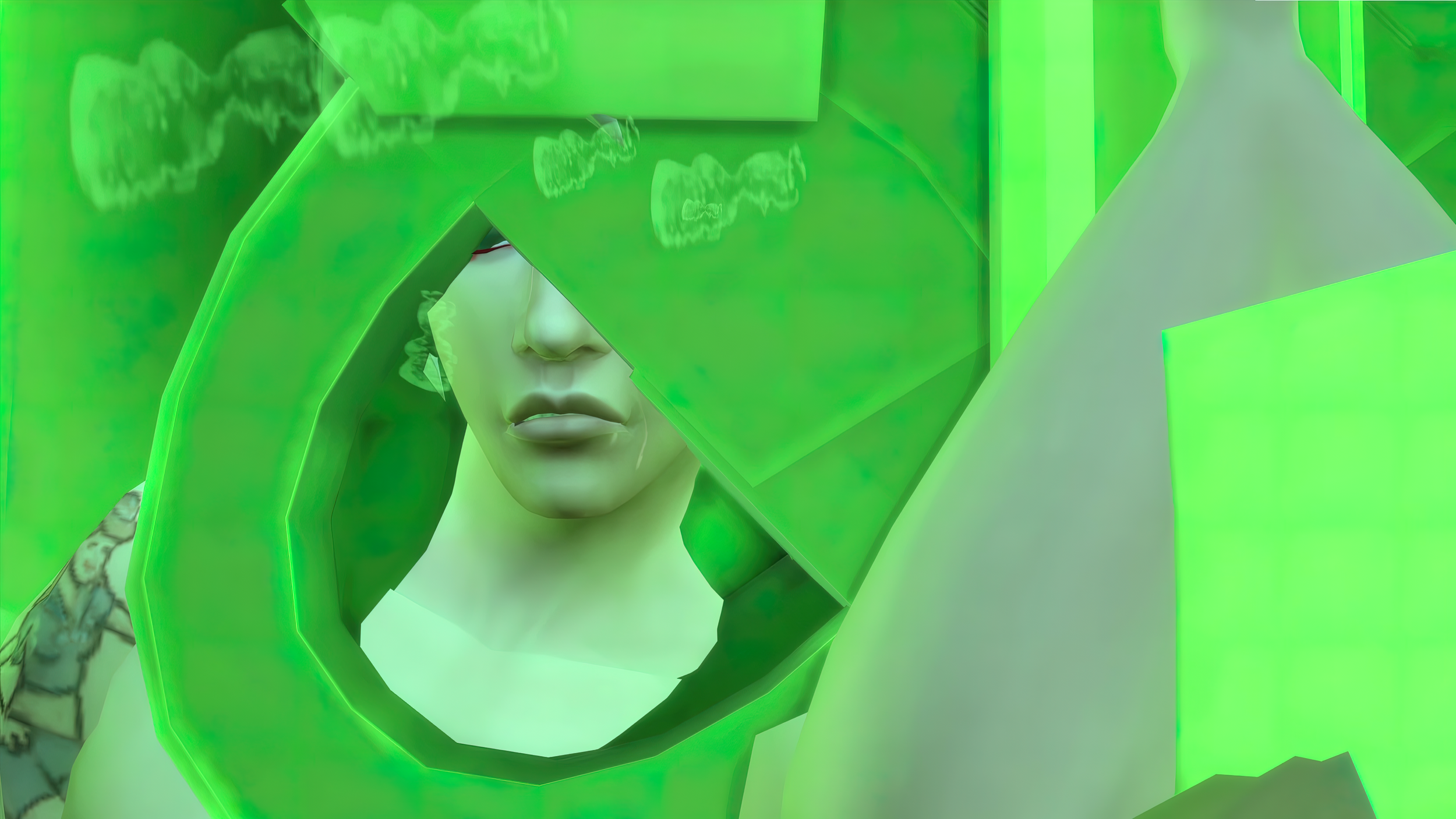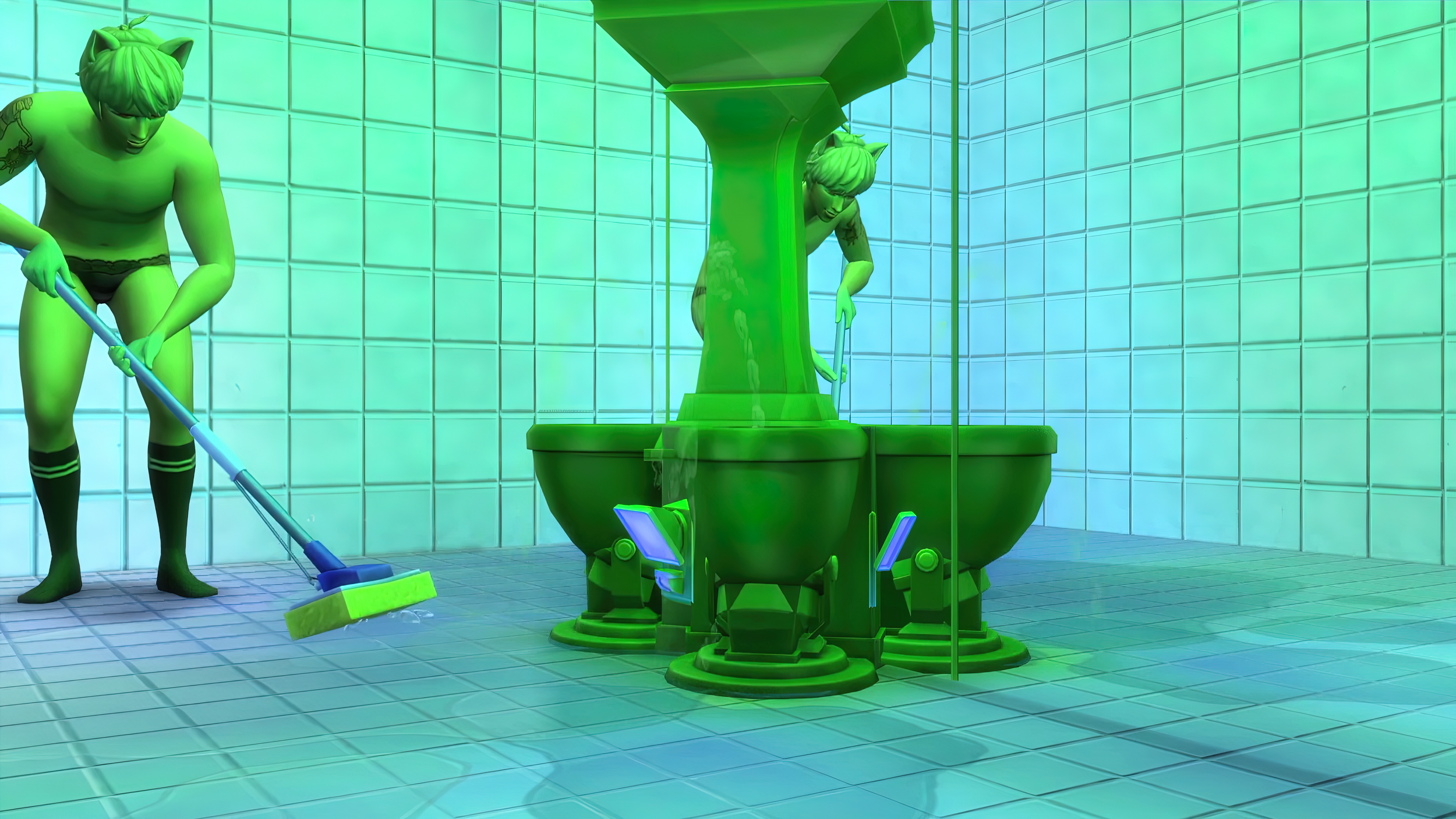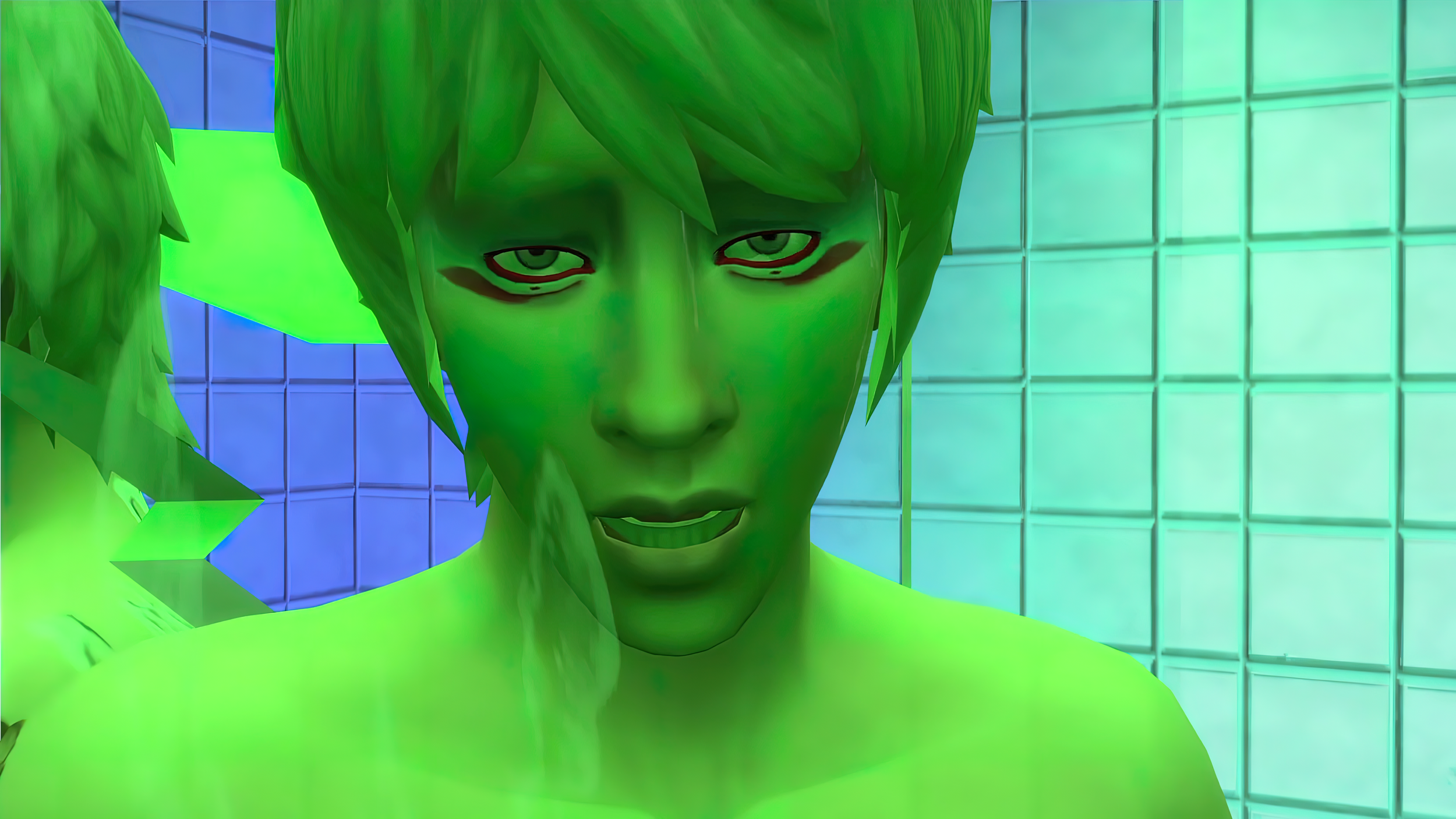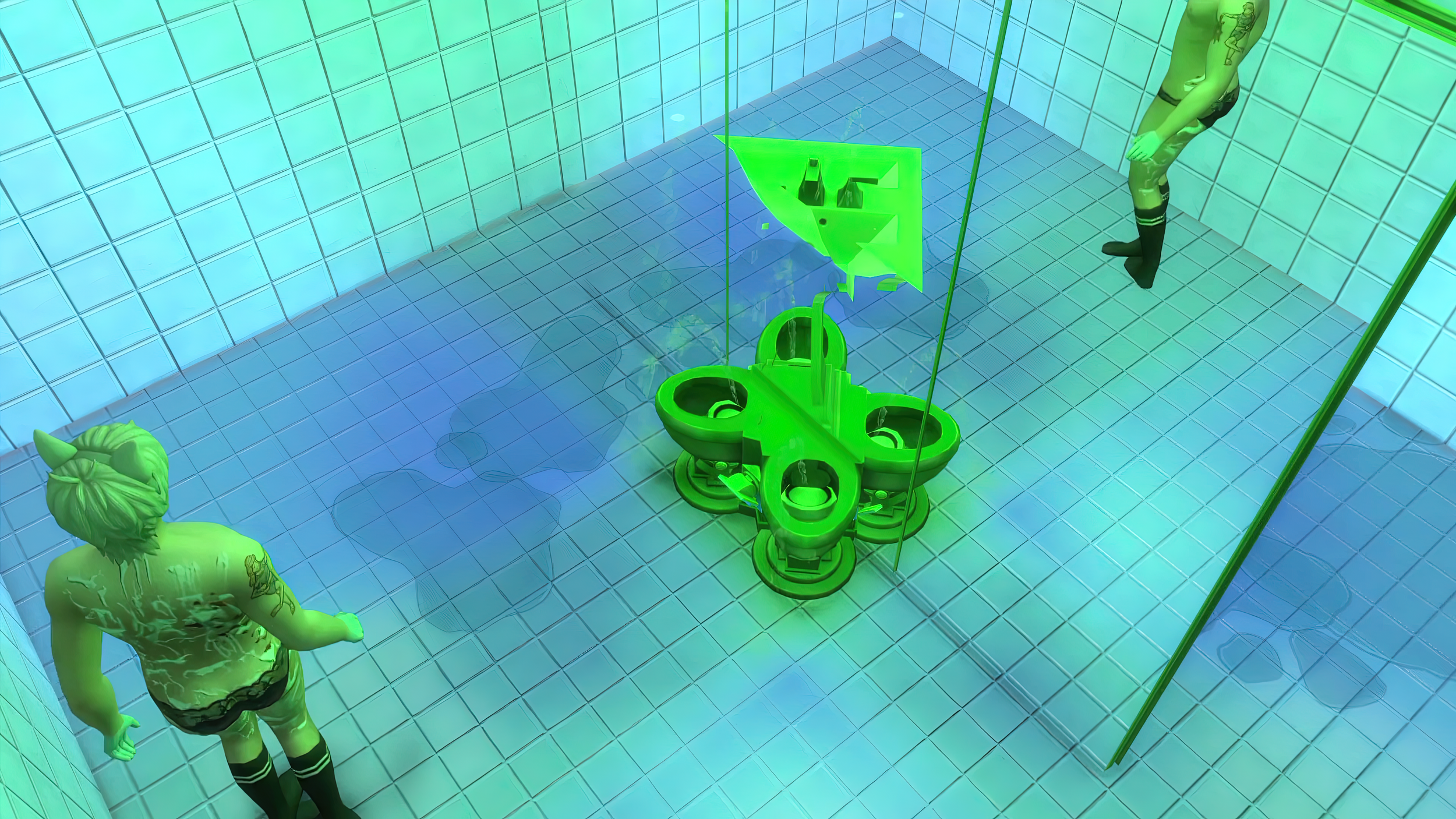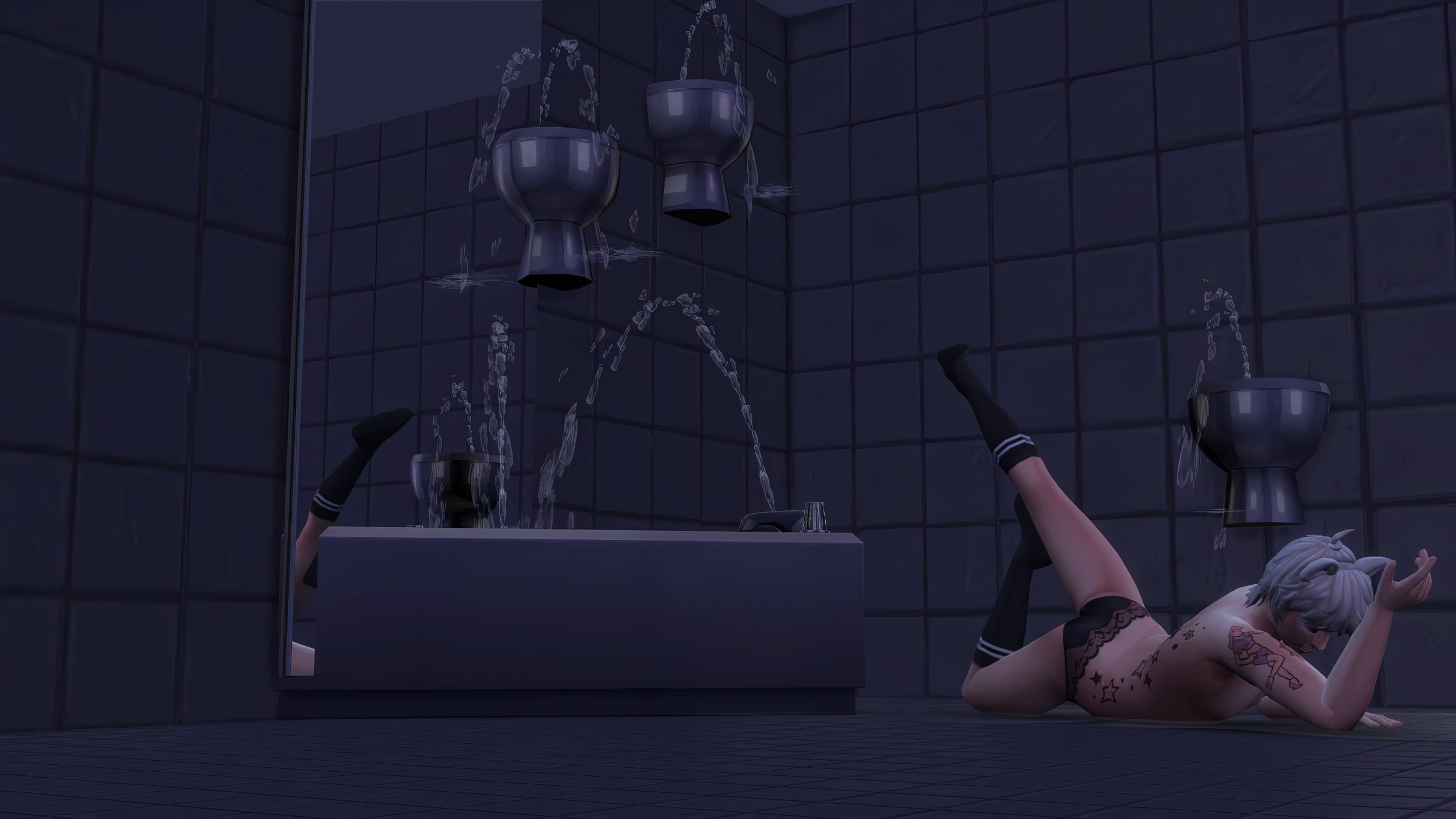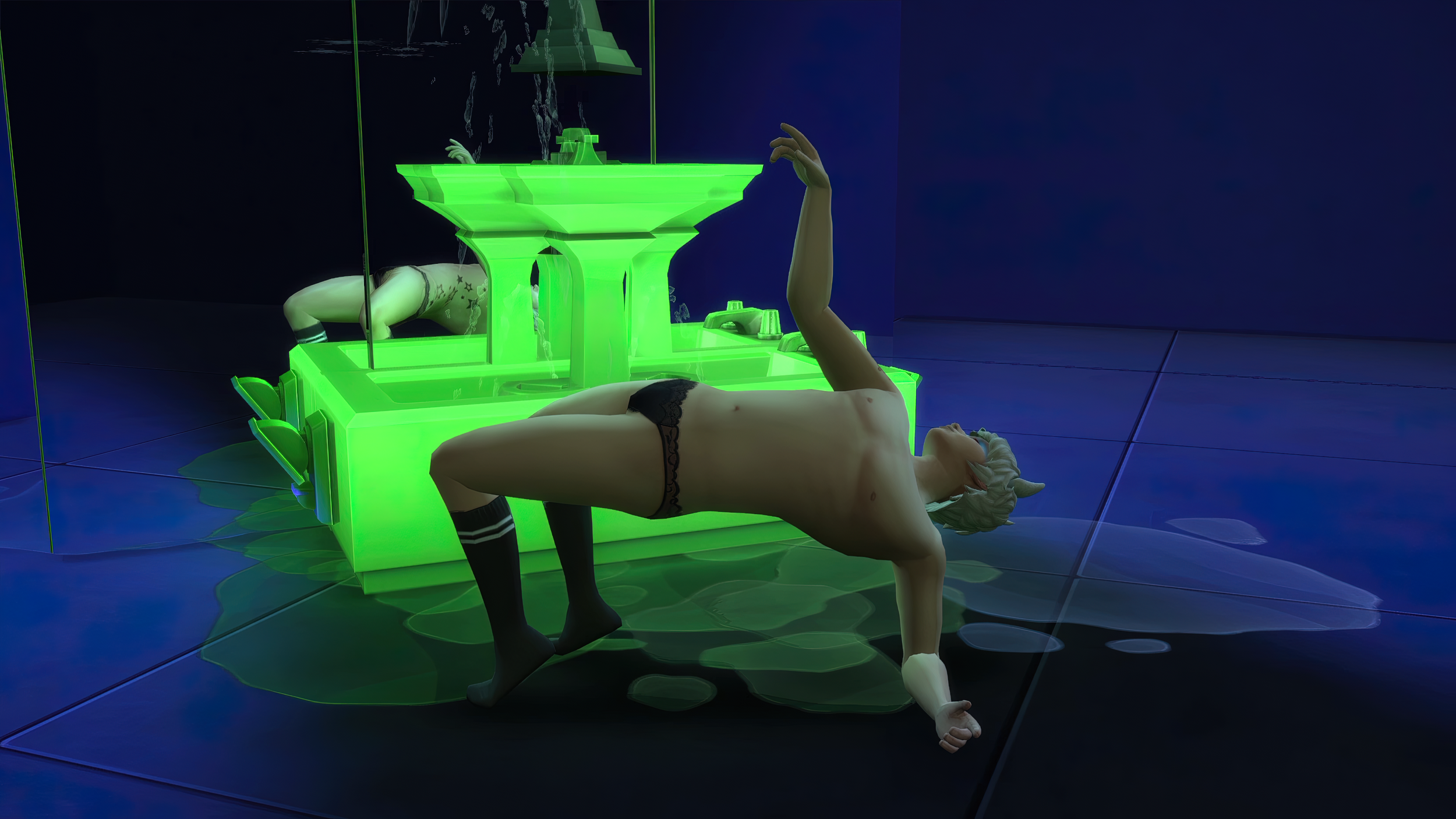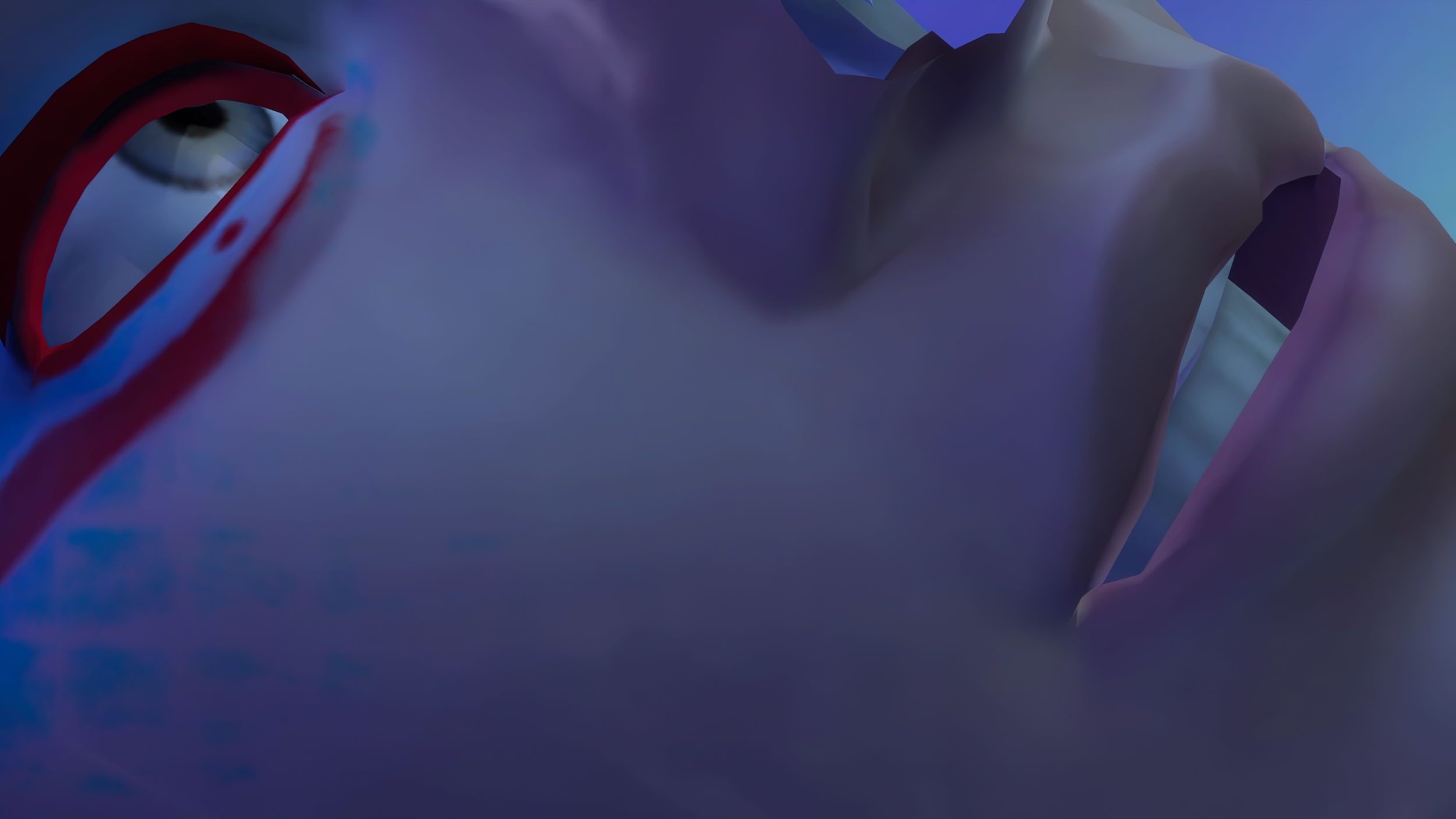but I wanna keep my head above water
digital video/machinima (1920 x 1080), color, sound, 10’ 30”, 2022, Italy
everynight i try to find the light but sometimes its too cold
digital video/machinima (1920 x 1080), color, sound, 1’ 01”, 2022, Italy
everynight i try to find the light — prélude
digital video/machinima (1920 x 1080), color, sound, 00’ 51”, 2022, Italy
Created by Federica Di Pietrantonio
viewer discretion is advised
Wet, steamy, and sticky. Federica Di Pietrantonio takes the viewer into her neon lit lavatory. In this humid, slushy environment, gender identities become fluid and seemingly solid architectures suddenly splinter. The camera lingers on a virtual nymph’s ecstatic expression as water first drips slowly, then faster and faster. Moments of intimacy are shared. Crevices are explored. Surfaces are scrubbed. This highly immersive experience will leave you soused.
Federica Di Pietrantonio was born in Rome in 1996. She studied painting at the University of Fine Arts in Rome. After receiving her B.A. in 2019, she did a residency at KASK (Ghent, Belgium), where she developed the project Vacation Spot with The Sims. In 2017, Di Pietrantonio was selected for Mediterranea 18 Young Artists Biennale and the following year she began a collaboration with Spazio In Situ as an artist and web designer. Her work has been exhibited in Italy, Belgium, and Portugal. She lives and works in Rome.
Gemma Fantacci: In a previous interview with Inside Art, you called your strong affinity for digital technology “an essential element” of your upbringing: your dad was a programmer and you were literally surrounded by computers. Can you describe your earliest encounter with video games? When and why did you decide to incorporate their aesthetics into your practice?
Federica di Pietrantonio: I remember the sound of my mother's keyboard and the cigarette burns on my father’s. As I began watching and listening to ASMR videos and following the performances of many youtubers, I realized that that sound – typing, that is – is one of my earliest ASMR experiences: I am talking about memories elicited by a sound that I can perceive on my own skin. During my childhood, I never considered the possibility that there could be a difference between the computer as a device and video games as software. To me, they were inseparable. The computer gave me a plethora of possibilities to imagine and to create. JavaScript game folders, html notepads, video game strategy guides collected via screen grabs, playlists on windows media player... Memory-wise, I tend to connect the many computers I used to the places where they were physically located and the various functions they performed. Among the video games in my surroundings I recall Lego Racers, Disney Magic Artist, several Flash games, Star Wars Night of the Old Republic II....and of course, The Sims. Thus, introducing video games into my art practice was a natural step. It happened when I experienced some kind of boredom. I was trying to make sense of the relationship between wasting time and working, and video games were the perfect case study to conduct such an investigation. From that moment on, I was able to recognize several connections between my own research and various activities within the context of virtual spaces.
Gemma Fantacci: Several artists working with video games feel the need – if not the urge – to repurpose their gameplay and spaces in order to reject the rules and boundaries set by the designers. Such an intervention often becomes the point of departure for a critical or creative exploration/critique of digital technology. I discern a similar strategy in your practice. Moreover, you seem to suggest that the concrete, tangible spaces we inhabit and the virtual spaces that we see on the screen are not mutually exclusive, antagonistic or divergent, but complementary. In your work this continuity or proximity is explicit. The way you shift from the screen to the canvas, from video art to painting, clearly says so. How do you approach the relationship between video games and painting as you explore the nexus between the self and the avatar?
Federica di Pietrantonio: The connection between painting and video games did not feel forced or artificial to me. It was an organic, spontaneous development. I felt the need to bring virtual spaces back onto the canvas for the first time with Second Life. To navigate the spaces of this virtual world, I created an avatar called Foxy. I wanted to document my presence or, rather, my passage through those layers of reality, and painting allowed me to move the screenshots or photographs I produced to a different plane of temporality and to create new scenarios and new spaces, both at the pictorial level of the canvas and at the narrative level, as storytelling. I wanted to have a permanent record of my experiences. Moreover, painting allows me to think about scale and size: I tend to work on large surfaces because I am interested in reproducing and simultaneously amplifying the concentration we experience when staring at a screen for long intervals of time and the possibility that once the painting is in front of us, it fills our entire field of vision.
Gemma Fantacci: but i wanna keep my head above water (2022) features Aster, a character from The Sims who recurs in several of your videos and paintings. Another recurring character in your oeuvre is the aforementioned, Foxy the avatar, which we first encountered in 2017. Their features are evocative of the furry subculture, especially in relation to gender and sexual fluidity. What role do they play within your work?
Federica di Pietrantonio: I often create new avatars on different platforms and for different purposes, whether in more intimate encounters or in shared settings such as playdates or similar. Each context requires a different way of thinking and planning: in my practice, the process of creating an avatar is central because it is an act of self reflection. But during the artistic process, creating an avatar is a more spontaneous gesture. It is a moment that I carve out without any prior conceptualization. I do not want to overthink it. I am interested in the referential clash of different worlds: what happens when different elements are juxtaposed? My goal is to create new signs and novel aesthetics that remain in that pleasantly bright limbo of ambiguity. Each avatar is created according to the specific idiosyncrasies of its platform, so shifting to a different medium like painting allows me to introduce the possibility for a broader, deeper discourse on identity than the narrow analysis of the character in his or her native place. I enjoy these kinds of intrusions! I am always thinking about the whereabouts of my avatars when I am not there with them ;)
Gemma Fantacci: but i wanna keep my head above water does not feature a soundtrack, as in your previous work, theres glitter on the floor, which was screened at the Milan Machinima Festival MMXXII. In its stead, we hear environmental sounds, such as the tinkling of water leaking from the pipes, or the squishy sound that the mop makes as it tries to dry the puddles. Last but not least, we hear a lot of simlish, The Sims’ fictional language. For the most part, however, silence prevails. Can you discuss the sound design of on but i wanna keep my head above water?
Federica di Pietrantonio: The soundtrack mainly features sounds taken from the water gushing from the malfunctioning hydraulic pump fountain. In my installation, the sound comes from four passive speakers placed at various spots in a sculpture made of polypropylene tubes. In this way, I am trying to create a synchronicity of moments between what happens in the video and what happens in the exhibition space. The basement of Adjacencies where it was first exhibited – as part of dumpster love yourself, a duo show with Andrea Frosolini, curated by Alessandra Ioalè and Adiacenze – was ideal, architecturally speaking, as it exuded moisture and cold from the walls and floor. I deliberately situate myself within the limit of the comfortable and the uncomfortable, of pleasure and annoyance, of enjoyment and disgust.
Gemma Fantacci: I was able to recognize several motifs both in your paintings and in your video art, such as the bathroom as a setting and the ubiquity of water. A place that sits between intimacy and self-display practices, the lavatory is a transitional space where we can try out different versions of ourselves away from inquisitive, often judgemental eyes, but at the same time it is one of the places where we expose ourselves to the gaze of others through self portraits that manufacture a carefully edited version of ourselves, the so called “mirror selfie” discussed by Joan Fontcuberta, among others. Conversely, water has been traditionally associated with the notions of (re)birth, life, transformation, and change. What role do these two elements play in your practice?
Federica di Pietrantonio: The bathroom is a place imbued with an intentionally young, adolescent and restless eye. I am fascinated by the boundary between self-care and self-presentation, two extremes of the same curved surface. The bathroom is a place that belongs as much to beauty as to horror. Scents and smells are constantly circulating, and the flowing waters reach places we don’t want to think about. The water closet is about waste, personal regeneration. I cannot unsee Slavoj Zizek’s famous joke about toilets and ideology. I find many similarities between the way we experience the bathroom as an architectural construct and the way we think/imagine/see ourselves.
Gemma Fantacci: In your videos, appliances tend to malfunction, or even fall apart: toilets start to leak water, and the sims freak out as they try to dry up puddles and fix flooded toilets. This phenomenon is consistent with Will Wright's comment that the objects in the simulated world of The Sims, inevitably break and fail, creating an increasingly difficult ecosystem to manage. Is your work also a meditation on the fragility of technology in the digital world?
Federica di Pietrantonio: Your question reminds me of two things that, in their own way, complement each other. A while ago, I wanted to better understand the inner logic of The Sims. Specifically, I wanted to understand how actions – their intentionality and consequentiality – are enacted within this simulation. So I tried to read as much as I could on the topic. With the introduction of new versions of the game as well as the coding itself, nowadays these dynamics are extremely complex. The game’s open embrace of unpredictability mimicking human experience can be eerily off-putting. I am fascinated by the possibility of experiencing something that simulates the complexity of reality on a screen, where I can manipulate or at least influence some outcomes. This, by the way, is the same appeal of painting: you create a world through your activity. A second reference I must mention is Call Me Kevin, a youtuber who makes videos about the endless challenges and idiosyncrasies one experiences by playing various games, including The Sims, in order to produce ironic, yet nihilistic outcomes.
Gemma Fantacci: The way you use The Sims’ virtual camera to investigate the bodies of the avatars is striking. Although in The Sims the player can act as a demiurge exerting an almost omnipotent influence over every aspect of the game, your intervention seems to confer the virtual characters some kind of bodily autonomy. Close-ups and inner explorations display a corporeality that refuses an easy subjugation by the player. What I am trying to say is that in your machinima, the virtual characters are not puppets, but rather subjects. Yours is “a gesture that seeks to claim the independence of the virtual body as an autonomous identity”, as you stated in our previous conversation. It’s almost like the glitches resulting from these “impossible” camera angles and movements grant the body some kind of materiality. What’s your take?
Federica di Pietrantonio: I like to embrace the unexpected in a scene, so I shoot the avatars’ actions without anticipating their behavior, trying to find the best shots to tell what is happening and what I am trying to discover as well. The camera becomes a prosthetic of my own eye, an inquisitive tool looking for other meanings than the banal actions the avatars eventually perform. Many of the videos I edited had no script or predefined storytelling; sometimes I try to build the story step by step, reviewing one action after another, without asking myself much about why. The motivations that lead the characters to act are related to the way they occupy their time. There is boredom but there’s also the need to fullfil their bodily desires. Often the filmed subjects look straight into the camera, while looking at themselves in the mirror. During the shooting, my desire to know more, or to simply want more, leads me to pierce the surface that separates the avatars from their surroundings.
Gemma Fantacci: The Sims is a cornerstone of your artistic practice, but you also experimented with Grand Theft Auto and Myst, among others. How does the nature of the game affect your authorial approach and intent?
Federica di Pietrantonio: The original environment does influence most of the characteristics, influences, and constraints in my attitude toward the platform. Some considerations or possible uses are related to the genre of the appropriated game, or the “natural” or “physical” laws governing its world. Myst for me was one of the first approaches to machinima in the closest, that is, in the most technical sense of the term. Through its narrative of loss, I tried to tell a story of a walk against time, going forward and backward simultaneously. I am fascinated by the interfaces and by the interaction between the game and the user. I also appreciate the kind of meditative, slow experience that Myst introduces in an otherwise frantic and manic context — mainstream video games — where the main goal is to shoot everything that moves as soon as you see it on the screen. I find myself on the same page as Jeffrey Shaw when it comes to viewing and experiencing art, but the same applies to concrete reality. Inside GTA, my approach changes again: I become an explorer rather than an observer, and I love the thrill of putting myself in dangerous situations that I would avoid in real life. The reassuring certainty of waking up in a virtual hospital somewhere in Los Santos, safe and sound, is liberating. I do not have a preferred way of looking at virtual platforms, as I try to intercept those liminal spaces and interstices where the real and the virtual overlap and the “natural laws” of the gamespace unravel.
Gemma Fantacci: Machinima is often presented under the label of “digital video” in many festivals and exhibitions. Is such nomenclature at all important to you? Are you partial to any definition in particular? In your experience, has the perception of machinima, i.e. game-based video art, changed in the past decade? Is your work received differently outside Italy?
Federica di Pietrantonio: I greatly appreciate the term “machinima”, both as a technical definition and as a reference to a fully fledged medium. I don’t think that “machinima” somehow narrows the scope and breadth of my video art. On the contrary, it enhances the digital material I am using. I learned about the existence of “machinima” relatively late. I was already engaging with this format, appropriating and repurposing video games. By using the term machinima in the description and accompanying text of my work, I have been able to clarify my intentions and my framework. It has also allowed me to be better informed. I started digging into the world of machinima, both at the level of research and display, which I find very useful. Recently I presented my work at MEET in Milan within the context of Atlas. The New Atlas of Digital Art, a conference and art exhibition. The opportunity to think critically about my work in a frame that challenges me as much as it excites me is really satisfying, and it allows me to both explore and expand theoretical aspects that I often experience on the screen. So far, I have had relatively few opportunities to present my work abroad, but I hope to change that soon.
Gemma Fantacci: Is there anything else you would like to add?
Federica di Pietrantonio:yes!
but I wanna keep my head above water
digital video/machinima (1920 x 1080), color, sound, 10’ 30”, 2022, Italy
everynight i try to find the light but sometimes its too cold
digital video/machinima (1920 x 1080), color, sound, 1’ 01”, 2022, Italy
everynight i try to find the light — prélude
digital video/machinima (1920 x 1080), color, sound, 00’ 51”, 2022, Italy
Created by Federica DI Pietrantonio
Courtesy of Federica Di Pietrantonio and The Gallery Apart, Rome
Made with The Sims 4 (Maxis/Electronic Arts, 2014)


